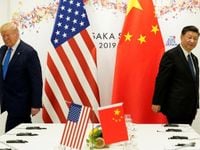For much of 2025, the world’s two largest economies—China and the United States—managed to keep their simmering trade tensions from boiling over. But the fragile calm shattered in October as a fresh volley of tariffs, export controls, and public recriminations sent shockwaves through global markets and left companies and consumers bracing for renewed economic turbulence.
It all began to unravel in the second week of October. After several months of relative quiet following a series of tit-for-tat tariffs in the year’s first half, China announced strict new limits on the export of rare earth minerals—materials essential for high-tech products ranging from smartphones to electric vehicles and military hardware. The move was a direct response to U.S. actions, according to China’s Ministry of Commerce, which cited a string of American measures since trade talks in Madrid the previous month. “China’s stance is consistent,” the ministry declared in a statement posted online on Sunday, October 12. “We do not want a tariff war, but we are not afraid of one.”
U.S. President Donald Trump wasted no time in responding. On Friday, October 10, he announced a sweeping 100% tariff on all Chinese exports to the United States, effective November 1, along with new export controls on critical software. “Let’s poke the bear again,” quipped Aleksandar Tomic, associate dean at Boston College, capturing the mood of escalation. Trump, in the Oval Office, acknowledged the uncertainty surrounding a planned meeting with Chinese President Xi Jinping later in the month: “I don’t know that we’re going to have it. I’m going to be there regardless, so I would assume we might have it.”
The tit-for-tat didn’t stop there. Both nations slapped new port fees on each other’s ships, and Washington expanded its blacklist of Chinese firms. Markets responded with alarm—the S&P 500 suffered its worst day since April, and tech stocks took a beating as investors fretted over the fallout. According to Bannockburn Capital Markets’ Marc Chandler, “Either this is it, the so-called tariff truce is over and both sides are going to rapidly escalate or these are negotiation talks ahead of the talks between Xi and Trump.”
China’s rare earth export restrictions struck a particularly sensitive nerve. The country produces over 90% of the world’s processed rare earths and rare earth magnets, materials critical for everything from electric vehicles to advanced military systems. On Thursday, October 9, Beijing added five more rare earth elements—including holmium, erbium, thulium, europium, and ytterbium—to its list of restricted exports. The new rules also require foreign companies to seek Chinese government approval before exporting products that contain rare earths sourced from China, no matter where those products are manufactured.
For American industries, the implications are stark. U.S. consumers, long accustomed to cheap goods from China, now face the prospect of higher prices. American soybean farmers, already reeling from lost Chinese sales, see their exports replaced by those from Brazil and Argentina. As Tomic put it, “It becomes an issue of who can replace supply chains faster. And, at least right now, I think China is winning that one.”
China, for its part, has so far stopped short of imposing new tariffs on U.S. products. Instead, it has opted for regulatory pressure and public messaging. The Commerce Ministry accused Washington of “provocative and damaging” actions and labeled Trump’s tariff threat a “typical example of double standards.” In a pointed online statement, the ministry emphasized, “Frequently resorting to the threat of high tariffs is not the correct way to get along with China.” It also reassured foreign companies that “China’s export controls are not export bans. Any export applications for civilian use that comply with regulations will be approved, and relevant enterprises need not worry.”
Yet, Beijing made clear it would not back down if Washington persisted. “If the U.S. side obstinately insists on its practice, China will be sure to resolutely take corresponding measures to safeguard its legitimate rights and interests,” the ministry warned. Analysts suggested that China’s decision to hold off on immediate countermeasures might signal an openness to negotiation, though others cautioned that patience could be wearing thin. Alfredo Montufar-Helu, managing director at GreenPoint, observed, “By clarifying the rationale behind its retaliatory measures, Beijing is also outlining a potential path forward for negotiations. The ball is now in the U.S. court.”
Meanwhile, China has also wielded its regulatory power against American companies. In October, the State Administration for Market Regulation (SAMR) announced antitrust investigations into U.S. chip giants Nvidia and Qualcomm. The latter was accused of failing to notify Chinese authorities about its acquisition of Israeli chip designer Autotalks, a move SAMR described as an “unlawful acquisition.” These actions underscore China’s willingness to use every tool at its disposal in the ongoing trade standoff.
The rare earths dispute has rattled not only U.S. firms but also global supply chains. Companies dependent on China’s dominance in rare earth processing are scrambling to assess the impact, though some, like Taiwan’s semiconductor industry, report little immediate effect. Taiwan’s economy ministry stated on October 12 that the elements covered by China’s expanded ban differ from those needed for its chip manufacturing, and most of its rare earth supplies come from Europe, the U.S., and Japan.
Amid the escalating rhetoric, both sides accuse each other of violating the spirit of a previous truce. Trump has called China “very hostile” and accused Beijing of holding the world “captive” by restricting access to rare earths and magnets. China has countered that the U.S. has introduced several new restrictions in recent weeks, including expanding the number of Chinese companies subject to export controls and imposing new port fees.
The renewed hostilities now threaten to derail a much-anticipated summit between Trump and Xi Jinping at the Asia-Pacific Economic Cooperation meeting in South Korea later this month. It would have marked their first face-to-face encounter since Trump’s return to office in January. But as of October 10, the status of the meeting was uncertain. “This kind of story doesn’t have a good guy,” Chandler remarked. “We want to have a good guy and a villain. But these are just two large countries both seeking national advantage.”
With both sides digging in and global markets on edge, the world is left watching—wondering whether this is the start of a new trade war or just another round of hardball negotiation between two economic giants unwilling to blink.

